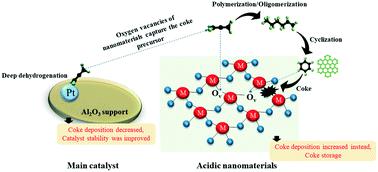当前位置:
X-MOL 学术
›
React. Chem. Eng.
›
论文详情
Our official English website, www.x-mol.net, welcomes your
feedback! (Note: you will need to create a separate account there.)
Influence of surface Sn species and hydrogen interactions on the OH group formation over spherical silica-supported tin oxide catalysts
Reaction Chemistry & Engineering ( IF 3.4 ) Pub Date : 2020-07-25 , DOI: 10.1039/d0re00178c Sirawat Boonpai 1, 2, 3, 4, 5 , Sippakorn Wannakao 6, 7, 8 , Kongkiat Suriye 6, 7, 8 , Victor Márquez 1, 2, 3, 4, 5 , Joongjai Panpranot 1, 2, 3, 4, 5 , Bunjerd Jongsomjit 1, 2, 3, 4, 5 , Piyasan Praserthdam 1, 2, 3, 4, 5 , Alexis T. Bell 9, 10, 11, 12
Reaction Chemistry & Engineering ( IF 3.4 ) Pub Date : 2020-07-25 , DOI: 10.1039/d0re00178c Sirawat Boonpai 1, 2, 3, 4, 5 , Sippakorn Wannakao 6, 7, 8 , Kongkiat Suriye 6, 7, 8 , Victor Márquez 1, 2, 3, 4, 5 , Joongjai Panpranot 1, 2, 3, 4, 5 , Bunjerd Jongsomjit 1, 2, 3, 4, 5 , Piyasan Praserthdam 1, 2, 3, 4, 5 , Alexis T. Bell 9, 10, 11, 12
Affiliation

|
Silica-supported tin oxide catalysts are currently used in chemical processes involving hydrogen. A deeper understanding of the interactions of molecular hydrogen with the catalyst surface is crucial, to gain insights into structure–activity relationships that control the catalytic performance. This work aims to explore the influence of Sn species on silica-supported tin oxide catalysts and in particular the role of OH groups formed during hydrogen exposure. Tin oxide supported on spherical silica nanoparticle (SSP) catalysts was investigated using in situ diffuse reflectance infrared Fourier transform spectroscopy (DRIFTS). The catalysts were synthesized using two different methods, incipient wetness impregnation (IWI-Sn) and incorporation (Inc-Sn) of Sn species to the SSP support with the sol–gel method. In situ DRIFTS showed that new OH groups on the silica surface are formed over SSP-supported tin oxide catalysts during the hydrogen exposure. The Sn–O–Si species play a key role in the formation of new OH groups on the silica surface over the catalysts. These Sn–O–Si species were predominant on the Inc-Sn catalysts, while the IWI-Sn catalyst presented various types of Sn species. Moreover, the Sn–O–Si species increased with the increase of Sn contents in both samples. The analytical results indicate that the newly generated OH groups appeared mostly on the silica surface surrounding the Sn–O–Si species.
中文翻译:

球形二氧化硅负载的氧化锡催化剂上表面Sn物种和氢相互作用对OH基形成的影响
二氧化硅负载的氧化锡催化剂目前用于涉及氢的化学过程中。深入了解分子氢与催化剂表面的相互作用至关重要,这对于深入了解控制催化性能的结构-活性关系至关重要。这项工作旨在探讨Sn物种对二氧化硅负载的氧化锡催化剂的影响,尤其是在氢暴露期间形成的OH基的作用。使用原位漫反射红外傅里叶变换光谱(DRIFTS)研究了球形二氧化硅纳米颗粒(SSP)催化剂上负载的氧化锡。催化剂是用两种不同的方法合成的:初湿浸渍法(IWI-Sn)和通过溶胶-凝胶法将Sn物种掺入SSP载体中(Inc-Sn)。原位DRIFTS表明,在氢气暴露过程中,在SSP负载的氧化锡催化剂上形成了二氧化硅表面上的新OH基。Sn-O-Si物种在催化剂上的二氧化硅表面上形成新的OH基团中起着关键作用。这些Sn-O-Si物种主要在Inc-Sn催化剂上,而IWI-Sn催化剂则呈现各种类型的Sn物种。此外,两个样品中的Sn–O–Si种类均随Sn含量的增加而增加。分析结果表明,新生成的OH基团主要出现在Sn–O–Si物种周围的二氧化硅表面上。
更新日期:2020-08-25
中文翻译:

球形二氧化硅负载的氧化锡催化剂上表面Sn物种和氢相互作用对OH基形成的影响
二氧化硅负载的氧化锡催化剂目前用于涉及氢的化学过程中。深入了解分子氢与催化剂表面的相互作用至关重要,这对于深入了解控制催化性能的结构-活性关系至关重要。这项工作旨在探讨Sn物种对二氧化硅负载的氧化锡催化剂的影响,尤其是在氢暴露期间形成的OH基的作用。使用原位漫反射红外傅里叶变换光谱(DRIFTS)研究了球形二氧化硅纳米颗粒(SSP)催化剂上负载的氧化锡。催化剂是用两种不同的方法合成的:初湿浸渍法(IWI-Sn)和通过溶胶-凝胶法将Sn物种掺入SSP载体中(Inc-Sn)。原位DRIFTS表明,在氢气暴露过程中,在SSP负载的氧化锡催化剂上形成了二氧化硅表面上的新OH基。Sn-O-Si物种在催化剂上的二氧化硅表面上形成新的OH基团中起着关键作用。这些Sn-O-Si物种主要在Inc-Sn催化剂上,而IWI-Sn催化剂则呈现各种类型的Sn物种。此外,两个样品中的Sn–O–Si种类均随Sn含量的增加而增加。分析结果表明,新生成的OH基团主要出现在Sn–O–Si物种周围的二氧化硅表面上。











































 京公网安备 11010802027423号
京公网安备 11010802027423号